Craft Traditions - Ash Basket Making
It is hard to imagine what life was like before we had plastic containers, paper bags, and cardboard boxes. But up until the 1800s, most things were carried or stored in baskets or wooden containers. Baskets can be made out of a variety of natural materials, including long fibrous leaves, long strands of certain types of grasses, bark, and strips of wood.
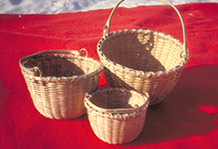
Three sizes of ash baskets made by
Newt Washburn.
In New England, baskets were made by the Native American tribes, which included the Penobscot, Maliseet, Pennacook, Abenaki, and Algonquin. They used a variety of local materials including birch bark, the spit wood of ash trees, and sweetgrass. When European settlers came to New England in the mid 1600s and 1700s, they brought their own basketry traditions. Over time, basket making traditions intermingled. Today, the skills and basket styles of New Hampshire reflect this shared heritage.
The strongest baskets in New England are made from strips of wood processed from brown ash trees. (In New Hampshire, the trees are called brown ash and in other regions of New England they are called black ash.) Brown ash is s finicky tree, usually growing in swampy areas and in small numbers. Because the wood is soft and splits, it is not much use for furniture making or building, but it is uniquely suited for basket making.
Commercial loggers use heavy machinery for logging and don't have time to separate out brown ash trees. Therefore, most basket makers get their logs by themselves or from independent loggers.
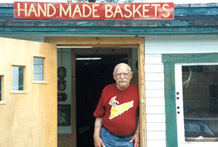
Newt Washburn carries on the
Sweetser family tradition
and recalls from his childhood,
"We made baskets to sell
all winter-either that or go hungry!"
When baskets were used for day-to-day living, they were made in many sizes and for many purposes. They were even used as a type of measurement. Bushel, half bushel, peck and half peck were once standard sizes. Large baskets were for heavy produce-potatoes, apples, squash, etc-and of course, laundry. Smaller baskets were for berry picking, flowers, and personal items. Some ash baskets were made as pack baskets and some even served as baby cradles.
Up until the 1940s, cash was hard to come by so skilled basket makers often traded or bartered their work with local stores for staples like flour, sugar, and coffee. For some families, like the Sweetsers of Northern New Hampshire, the making of baskets was a family enterprise and every member had a job to do. The Shakers also made baskets, selling them to "the world" to gain cash for their Shaker community.
Preparing wood strips for making an ash basket is a lot of work. First you need to pound steadily along the log to loosen the growth rings, which will separate into nice even layers called splints. These layers can be split again to get the thickness desired for a particular size and type of basket. The basketmaker then needs to get the strips the correct width for the basket. Many basket makers have ingenious devices with razor blades evenly spaced and secured in what is called a "stripper" to do this job.
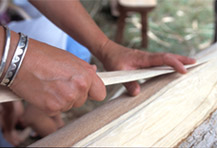
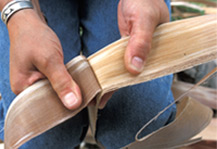
Alice Ogden looses a strip of bark and peels it off the log and then pulls apart the splint lengthwise to create a thinner strip.
The weavers can create a standard over-one under-one pattern, or any variety of decorative patterns. Sometimes the basketmaker will add additional decorative strips of similar or contrasting materials that twirl into points along the outside of a basket, creating with Native American weavers call "fancy" baskets. Sometimes materials like sweet grass or ash died different colors are used to vary the color and fragrance of the basket.
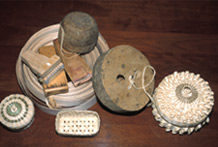
Jeanne Brink's delicate
ash and sweet grass baskets
displayed with her weaving materials,
which include strippers,
wooden molds, and a
roll of prepared ash splints.
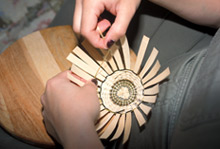
Apprentice Elizabeth Charlebois
starts her basket by
threading her weaver in
and out of the spokes.
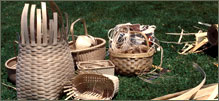
Bob Gelinas displays a variety of
basket shapes in various stages
of completion at the
2002 Canterbury Shaker Village
Wool Days program.
When the basket is the desired height, the vertical spokes are tucked back into the basket and a rim is lashed into place with thin strips of ash of other fiber. Many basket makers carve their own handles from the center of the ash log, after all the usable layers have been pounded off.
For more information on ash baskets, go to a search engine, like Google or Bing, and type in ash baskets. A wide variety of websites representing traditional basket makers will appear!
Photo credit: Lynn Martin Graton
New Hampshire State Council on the Arts
19 Pillsbury Street - 1st Floor, Concord, NH 03301


